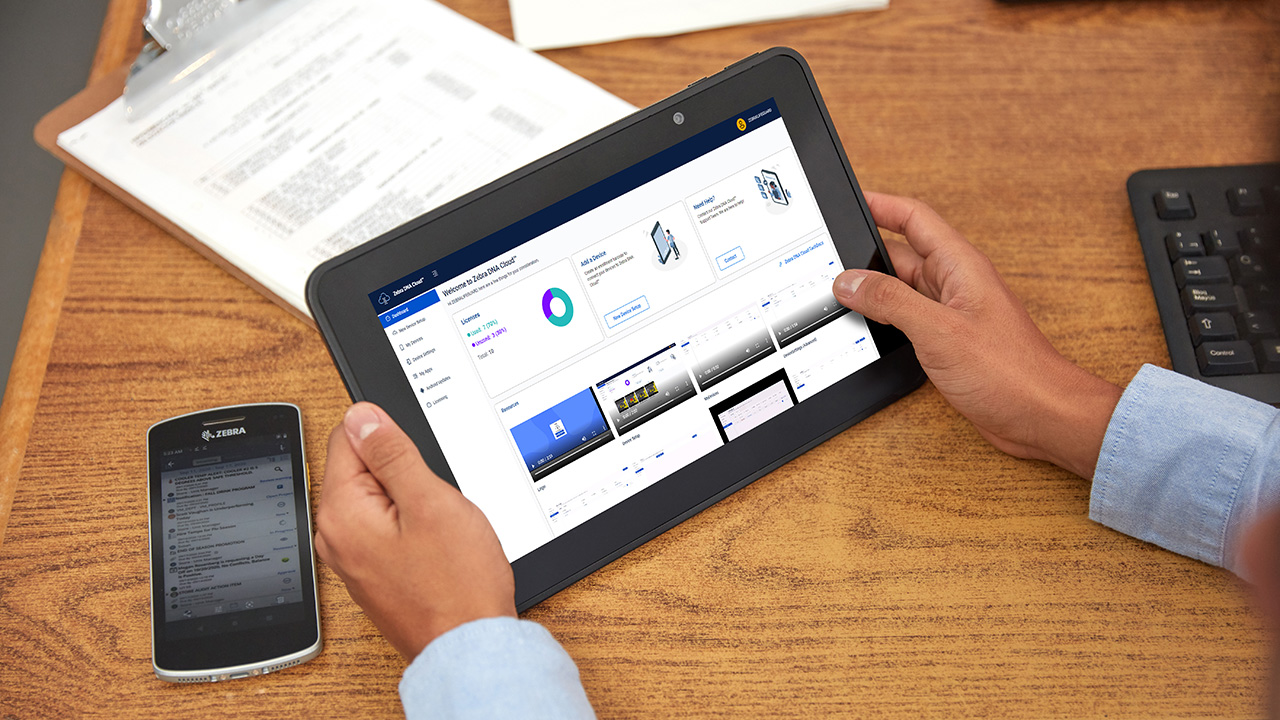
Ask the Expert: What Is Zebra DNA Cloud? And Does It Replace My Enterprise Mobility Management Solution?
Zebra’s Mobility DNA software suite is core to every Zebra handheld mobile computer, wearable and tablet used by your front-line workers. It’s the toolset that helps power and protect devices, save workers time, and prevent IT team burnout. It’s also the key to device longevity, around-the-clock device availability, and overall fleet manageability.
Some might argue that an enterprise mobility management (EMM) platform is the glue that holds a mobility solution together – that keeps the operating system (OS) updated, devices fortified against security threats, and apps running optimally. They aren’t wrong. However, some of the above actions actually leverage Mobility DNA under the covers.
That’s right…the EMM isn’t always the only answer to problems you might face when managing mobile technology solutions. In fact, Zebra’s Mobility DNA software suite was built primarily to offer solutions to problems the EMM and Google alone don’t solve. Each of the Mobility DNA tools available today have been designed to help maximize mobile device user productivity and minimize IT complexities, extend each deployed device’s lifecycle and, in the end, lower your total cost of ownership (TCO) for mobile technology overall.
As the size and importance of the Mobility DNA suite has grown, though, we’ve realized that it can be hard to keep track of every required mobile device management action and every tool required to take action. That’s why we created Zebra DNA Cloud, a new way to access your Mobility DNA tools in one place.
Here to give us the full scoop on Zebra DNA Cloud, how it works, and how it compares to (and complements) an EMM is Adam Arruda the Senior Product Manager for Device Lifecycle Solutions within Zebra’s Enterprise Mobile Computing unit:
Your Edge Blog Team: First off, what is Zebra DNA Cloud?
Adam: It's a new cloud-based interface that gives anyone responsible for managing Zebra handheld mobile computers, wearables and tablets a way to easily access the solutions we’ve built to help deploy, manage, and optimize every stage of their devices’ lifecycle. The Zebra Mobility DNA tools customers need most are now consolidated into this single cohesive Zebra DNA Cloud interface.
Your Edge Blog Team: So, this is something that will make the IT team’s job easier?
Adam: Zebra DNA Cloud is designed to help everybody, from IT to operations managers to Zebra mobile device users and third-party partners. What I like most about this new intuitive interface is that even a non-technical person can log in, see available tools, and use them to effectively stage, configure, monitor and update a device.
Your Edge Blog Team: Can Zebra DNA Cloud be used to set up automatic OS, application, or security updates as well?
Adam: Yes, it can be used to update apps and the Android OS over the air in a simplified manner. Plus, with Zebra DNA Cloud, organizations can tailor device settings to meet their specific needs by leveraging Mobility Extensions (Mx). So, they’ll be able to manage and configure applications however needed to ensure users have access to the applications required to accomplish their work. Administrators can also leverage LifeGuard OTA to ensure their devices are always up to date with the latest features and security, all with a single click—and without having to physically touch each device.
Your Edge Blog Team: Zebra Mobility DNA tools have been around for years. Why did you decide to create this consolidated cloud-based interface now?
Adam: You’re right, over the years we’ve introduced numerous tools as part of Mobility DNA to help our customers and partners get more out of their devices. The one glaring challenge we identified was the fact that, because these tools had been built over a number of years, there were some inconsistencies in how they look and work and where they are deployed. They also lacked the ability to work together in some cases in terms of how they exchanged data. Plus, with more and more customers using the cloud, it opened the door to have this seamless interface for our value-added solutions, such as Enterprise Keyboard, Enterprise Browser, LifeGuard OTA, and the like.
Your Edge Blog Team: Has the functionality of any Mobility DNA tool changed with Zebra DNA Cloud? Or just the way the Mobility DNA toolset is now accessed?
Adam: The beauty of what we are doing is that we’re harnessing the power of the mobile device management solutions we’ve already made an investment in and creating a new, improved way for customers and partners to interact with them. Zebra DNA Cloud really takes advantage of the existing Zebra software, as you mentioned, to provide all parties access to the secure solutions they need to help deploy, manage and support every stage of device lifecycles.
Your Edge Blog Team: If a customer already has an EMM, why should they pay for Zebra DNA Cloud as well?
Adam: Great question. Today, many of our customers use third-party EMM solutions to help manage their mobile device fleets, which is awesome and the reason we work so closely with our EMM independent software vendor (ISV) partners. That said, these same customers still look to Zebra to fill use cases and needs of their devices’ lifecycles that may not be possible for their EMM to solve. For example, things like LifeGuard OTA updates, Zebra application configuration, and battery health insights are tools and capabilities they won’t get with an EMM. However, Zebra DNA Cloud will provide that unified interface for these features (and more), and that interface (and all Zebra Mobility DNA tools) will coexist with a customer’s existing EMM.
Your Edge Blog Team: Can you leverage Zebra DNA Cloud if you don’t have an EMM?
Adam: Absolutely. The great thing about this interface is that it will work both with and without an EMM platform in place. In fact, those customers with very basic requirements for managing their devices could use Zebra DNA Cloud in lieu of an EMM. Mobility DNA already supports these requirements in full, so they wouldn’t lose any device management capabilities by opting for Mobility DNA – and Zebra DNA Cloud access - alone. Down the line, if they require more capabilities and control that only a third-party EMM offers, they can migrate from Zebra DNA Cloud to that EMM.
Until then, I highly recommend that anyone who does not have an EMM take full advantage of Zebra DNA Cloud. It’s the easiest way to see what’s happening with their devices, the most efficient way to maintain their fleet, and the best way to help keep mobile devices secure. Without Zebra DNA Cloud, it’s going to be more difficult to ensure devices have the latest features and are protected against the growing number of threats. It will also take far more resources to keep devices available so front-line workers can stay productive. Plus, with Zebra DNA Cloud, you can limit user access to devices, apps and even the Mobility DNA tools, which helps reduce system vulnerabilities.
Your Edge Blog Team: Is there a charge to use Zebra DNA Cloud?
Adam: Customers can use some features free of charge, however there are select features that have a small license fee. That’s why we say Zebra DNA Cloud is a freemium offering. Many of the existing Mobility DNA tools like StageNow, Enterprise Keyboard Designer or Power Precision Console were free before and will remain free in the cloud. However, tools used to manage LifeGuard updates, install applications and implement configurations over the air will be part of the licensed tool. Anyone who wants to confirm what’s free and what requires the licensing fee should speak with their Zebra account manager or partner.
Your Edge Blog Team: If a customer decides not to use Zebra DNA Cloud, can they continue to use Zebra Mobility DNA tools as they do today?
Adam: They can. We have no plans to end support for existing tools with the launch of Zebra DNA Cloud, although we believe that by moving them to a centralized, intuitively designed portal, it will make it easier for our customers and partners to benefit from them. Existing solutions will still be available on Zebra’s Support Portal for download or, in some cases, Google Play.
Your Edge Blog Team: Though Zebra DNA Cloud was just officially released, some customers had the opportunity to trial it during beta testing, correct? What was their feedback?
Adam: Over the past 2+ years, we worked with a number of partners globally to help test different solution concepts, provide feedback on use cases they encounter, as well as validate that this solution really filled a need. The feedback has been critical in allowing us to get to where we are today. It has been clear from their feedback that keeping things simple (non-technical) and easy to use was of utmost importance to making this product a success, which we believe we’ve been able to achieve. Also, we highlighted a number of different use cases we thought we could solve and had our partners validate those, which ensured we weren’t going to compete with any of our independent software vendor (ISV) or value-added reseller (VAR)/Zebra Alliance partners, and that Zebra DNA Cloud would actually fill holes that exist today.
###
Editor’s Note:
You can learn more about Zebra DNA Cloud here or by contacting your Zebra account manager.
###
Related Reads:

Adam Arruda
Adam Arruda is a Product Manager responsible for driving Zebra's partner-facing Administrator Tools strategy. He has more than 15 years of technology industry experience and has spent the past eight years in the Mobile Management and Support space. He works closely with ISVs, OEMs and VARs to help customers execute effective mobile strategies.




